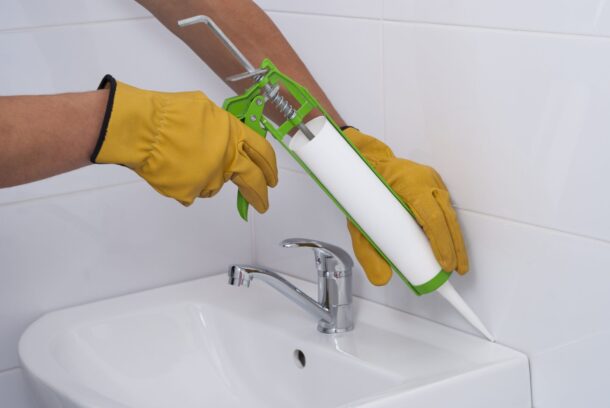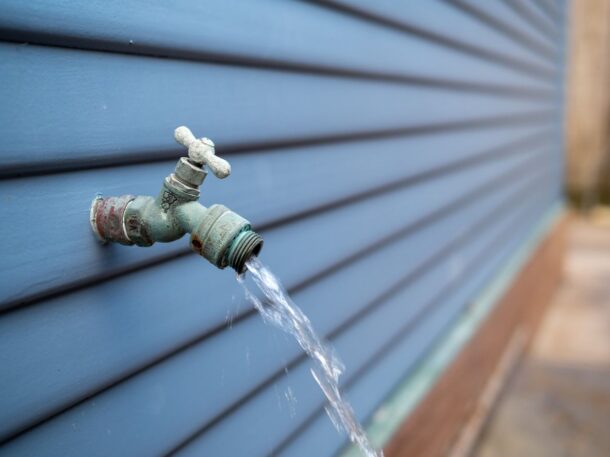By Sean Comerford
Silicone sealant is an essential tool for plumbers and contractors alike. Known for its flexibility, durability, and water resistance, it proves invaluable across a broad spectrum of plumbing applications, effectively sealing everything from air to water. This article delves into advanced techniques and best practices for using silicone sealant and offers unconventional uses for plumbing situations.

Advanced Techniques for Using Silicone Sealant
Proper Application Methods: The effectiveness of silicone sealant largely depends on how well it is applied. Ensure the application area is clean, dry, and debris-free. Use a caulking gun to apply a continuous bead of sealant, maintaining steady pressure to avoid air bubbles. Smooth the bead with a caulking tool or your finger dipped in soapy water to achieve a clean finish.
Accurate Sealing in Difficult Areas: Sealing tight or awkward spaces can be tricky. Utilize specialized tools like angled nozzles and flexible extension tubes to reach narrow gaps and corners. When dealing with vertical surfaces, apply the sealant from the bottom up to prevent sagging.
Enhanced Bonding to Various Materials: Silicone sealant is highly effective in bonding various materials, including glass, metal, and plastic. For optimal adhesion, choose a sealant compatible with the specific materials you are working with. Apply a primer if recommended by the manufacturer to enhance bonding strength, especially on non-porous surfaces.
Leveraging Tools for Maximum Performance: Leverage tools such as caulking guns with adjustable pressure settings, smoothing spatulas, and silicone finishing kits to refine your application. These tools improve the quality of your work and increase efficiency, allowing for faster completion times.

Best Practices for Silicone Sealant Application
Surface Preparation: Proper surface preparation is crucial for a successful seal. Clean the area thoroughly with a degreaser or alcohol-based cleaner to remove any oils or residues. Use a wire brush or sandpaper to roughen smooth surfaces, ensuring better grip for the sealant.
Choosing the Right Type of Silicone Sealant: Different plumbing tasks require different types of silicone sealant. For example, opt for high-temperature silicone for areas exposed to heat, while mildew-resistant sealant is ideal for bathroom and kitchen applications. Read product labels carefully to select the appropriate sealant for your specific needs.
Handling and Curing Considerations: Proper handling and curing are vital for the longevity of the seal. Store sealant tubes in a cool, dry place and ensure they are within their expiration date. After application, allow sufficient curing time as specified by the manufacturer, typically 24 to 48 hours. Avoid exposing the sealant to water or extreme temperatures during this period.
Maintenance and Longevity Strategies: To extend the life of your silicone seals, conduct regular inspections and touch-ups as needed. Remove and reapply sealant if you notice any signs of degradation, such as cracking or peeling. Use UV-resistant silicone for outdoor applications to prevent damage from sun exposure.

Unique or Less-Known Applications of Silicone Sealant in Plumbing
Downspouts: Silicone sealant can effectively seal seams and joints on downspouts in residential and commercial buildings. It can be especially beneficial in regions with heavy rainfall or snowfall, where water can easily penetrate cracks and weaken the downspout’s structure. It can also help reinforce the connections between different sections of the downspout, ensuring a secure fit that can withstand harsh weather conditions.
Hose Bib: When installing or repairing a hose bib, consider using silicone sealant around the base where it meets the wall to reinforce the bond. This watertight seal can prevent leaks and potential water damage while ensuring a secure connection capable of withstanding external stressors. Silicone’s elasticity allows it to expand and contract without losing its seal, making it perfect for outdoor applications.
Sewage Ejectors or Sump Pumps: When dealing with sewage ejectors or sump pumps where pipes protrude through a basement wall or foundation, consider applying a silicone sealant to create a watertight seal and prevent any potential leaks or seepage. This serves to protect the surrounding area from water damage and corrosion while also ensuring the efficient operation of the pump.
Roof Penetrations: Silicone sealant can serve as a viable temporary solution for addressing roof penetrations when immediate repair of the roof flashing is not feasible. By applying silicone sealant around the area of the roof penetration, a temporary barrier is created to prevent water leaks and potential damage until a permanent fix can be implemented by a professional roofer. This quick and easily accessible option can provide temporary relief and protection until the repair can be completed.
Silicone sealant is an indispensable product in the plumbing industry, offering versatility and reliability for many applications. Its superior water resistance, flexibility, and ease of use make it a preferred choice among plumbing professionals. By following these techniques and best practices and exploring unique applications, plumbers and contractors can maximize silicone sealant’s benefits.
 Sean Comerford is a Technical Applications Manager at Oatey Co. He is a third-generation tradesman with nearly 20 years of plumbing experience, including serving as the lead plumber for commercial/residential new-construction, service and fire protection jobs. He holds a State of Ohio Fire Protection License for Sprinkler and Standpipe.
Sean Comerford is a Technical Applications Manager at Oatey Co. He is a third-generation tradesman with nearly 20 years of plumbing experience, including serving as the lead plumber for commercial/residential new-construction, service and fire protection jobs. He holds a State of Ohio Fire Protection License for Sprinkler and Standpipe.




Join the conversation: